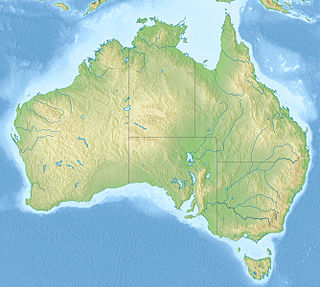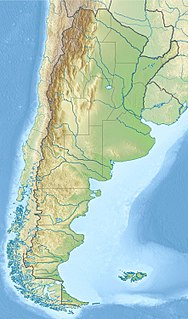The Twin Mountains Formation, also known as the Twin Mountain Formation, is a sedimentary rock formation, within the Trinity Group, found in Texas of the United States of America. It is a terrestrial formation of Aptian age, and is notable for its dinosaur fossils. Dinosaurs from this formation include the large theropod Acrocanthosaurus, the sauropod Sauroposeidon, and the ornithopod Tenontosaurus. It is the lowermost unit of the lower Cretaceous, lying unconformably on Carboniferous strata. It is overlain by the Glen Rose Formation. It is the lateral equivalent of the lower part of the Antlers Formation.
The Paw Paw Formation is a geological formation in Texas whose strata date back to the Early Cretaceous. Dinosaur remains are among the fossils that have been recovered from the formation.
The Hastings Beds is a geological unit that includes interbedded clays, silts, siltstones, sands and sandstones in the High Weald of southeast England. These strata make up the component geological formations of the Ashdown Formation, the Wadhurst Clay Formation and the Tunbridge Wells Sand Formation. The term 'Hastings Beds' has been superseded and the component formations are included in the Wealden Group.
The Castellar Formation is a geological formation in La Rioja and Teruel, Spain whose strata date back to the Early Cretaceous. Dinosaur remains are among the fossils that have been recovered from the formation.
The Obernkirchen Sandstein is a geological formation in Lower Saxony, Germany whose strata date back to the Early Cretaceous. Dinosaur remains are among the fossils that have been recovered from the formation.
The Bauxite of Cornet is a geological formation in Romania whose strata date back to the Early Cretaceous. Dinosaur remains are among the fossils that have been recovered from the formation.
The Khuren Dukh Formation is a geological formation in Mongolia whose strata date back to the middle to late Albian. Dinosaur remains are among the fossils that have been recovered from the formation.
The Lura Formation is a geological formation in western China whose strata date back to the Early Cretaceous. Dinosaur remains are among the fossils that have been recovered from the formation.
The Dashuigou Formation is a geological formation in Inner Mongolia, north China, whose strata date back to the Early Cretaceous period.
The Ulansuhai Formation is a geological formation in Inner Mongolia, north China. Dinosaur remains are among the fossils that have been recovered from the formation.
The Ejinhoro Formation is a geological formation in Inner Mongolia, north China, whose strata date back to the Early Cretaceous period (Aptian/Albian age.
The Sao Khua Formation is a middle member of the Khorat Group. It consists of an alteration of pale red to yellowish-gray, fine to medium-grained sandstone and grayish-reddish brown siltstone and clay. Rare pale red to light gray conglomerates, containing carbonate pebbles, are also characteristic of this Formation. This geological formation in Thailand, dates to the Early Cretaceous age.
The Grès supérieurs Formation is a geological formation in Laos whose strata date back to the Early Cretaceous. Dinosaur remains are among the fossils that have been recovered from the formation. It is equivalent to the Khok Kruat Formation of Thailand. Dinosaur remains are among the fossils that have been recovered from the formation.

The Bungil Formation is a geological formation in Australia whose strata date back to the Early Cretaceous. Dinosaur remains are among the fossils that have been recovered from the formation.

The Mackunda Formation is a geological formation in Queensland, Australia whose strata date back to the Early Cretaceous. Dinosaur remains are among the fossils that have been recovered from the formation.

The Allaru Formation, also known as the Allaru Mudstone, is a geological formation in Queensland, Australia, whose strata date back to the Early Cretaceous. Dinosaur remains are among the fossils that have been recovered from the formation.

The Griman Creek Formation is a geological formation in northern New South Wales and southern Queensland, Australia whose strata date back to the Albian to Cenomanian. Dinosaur remains are among the fossils that have been recovered from the formation.

The Lecho Formation is a geological formation in the Salta Basin of the provinces Jujuy and Salta of northwestern Argentina. Its strata date back to the Early Maastrichtian, and is a unit of the Salta Group. The fine-grained bioturbated sandstones of the formation were deposited in a fluvial to lacustrine coastal plain environment.

The Allen Formation is a geological formation in Argentina whose strata date back to the Late Cretaceous (middle Campanian to early Maastrichtian. Dinosaur remains are among the fossils that have been recovered from the formation.




